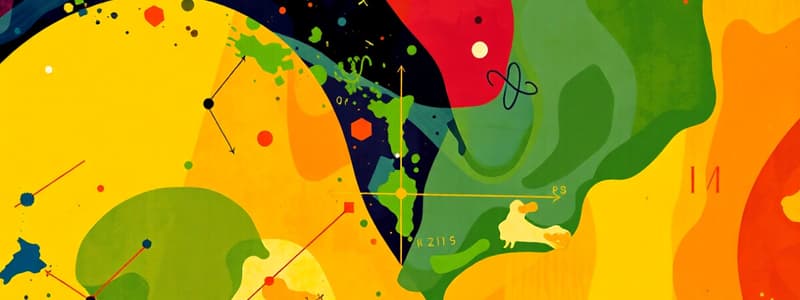Podcast
Questions and Answers
Which area of mathematics is MOST concerned with the study of properties that remain unchanged under continuous deformations?
Which area of mathematics is MOST concerned with the study of properties that remain unchanged under continuous deformations?
- Trigonometry
- Topology (correct)
- Fractal Geometry
- Differential Geometry
The twin prime conjecture is a solved problem in number theory.
The twin prime conjecture is a solved problem in number theory.
False (B)
What is the process of extracting the underlying essence of a mathematical idea from real-world objects called?
What is the process of extracting the underlying essence of a mathematical idea from real-world objects called?
abstraction
The branch of applied mathematics that deals with the collection, analysis, interpretation, and presentation of data is known as ______.
The branch of applied mathematics that deals with the collection, analysis, interpretation, and presentation of data is known as ______.
Match the following types of numbers with their descriptions:
Match the following types of numbers with their descriptions:
Which of the following mathematical areas is primarily used for creating descriptions of real-world systems?
Which of the following mathematical areas is primarily used for creating descriptions of real-world systems?
Calculus was primarily developed to study static states and equilibrium.
Calculus was primarily developed to study static states and equilibrium.
Name a field where investigations of prime numbers have significant applications.
Name a field where investigations of prime numbers have significant applications.
In the context of structure in mathematics, systems such as groups, rings, and fields are studied within the branch of ______ algebra.
In the context of structure in mathematics, systems such as groups, rings, and fields are studied within the branch of ______ algebra.
Which of the following is NOT typically considered one of the main branches of mathematics concerning fundamental aspects?
Which of the following is NOT typically considered one of the main branches of mathematics concerning fundamental aspects?
Flashcards
What is mathematics?
What is mathematics?
The study of quantity, structure, space, and change.
What is abstraction?
What is abstraction?
Extracting the underlying essence of a mathematical concept and separating it from real-world objects.
What is Number Theory?
What is Number Theory?
The study of the properties of integers.
What are rational numbers?
What are rational numbers?
Signup and view all the flashcards
What are complex numbers?
What are complex numbers?
Signup and view all the flashcards
What is Abstract Algebra?
What is Abstract Algebra?
Signup and view all the flashcards
What is Space (in Math)?
What is Space (in Math)?
Signup and view all the flashcards
What is topology?
What is topology?
Signup and view all the flashcards
What is Applied Mathematics?
What is Applied Mathematics?
Signup and view all the flashcards
What is Statistics?
What is Statistics?
Signup and view all the flashcards
Study Notes
- Mathematics is the study of topics such as quantity, structure, space, and change.
- There are different views among mathematicians and philosophers as to the exact scope and definition of mathematics.
- Mathematics seeks out patterns and formulates new conjectures.
- Mathematicians resolve the truth or falsity of conjectures by mathematical proofs.
- Mathematical proofs are arguments sufficient to convince other mathematicians of their veracity.
- Mathematical research is required to solve mathematical problems.
- Mathematics is essential in many fields, including natural science, engineering, medicine, finance, and social sciences.
- Applied mathematics is the application of mathematical methods to different fields.
History
- The history of mathematics is intertwined with the progress of science.
- Mathematical study began with arithmetic, geometry, and trigonometry.
- Mathematical study continues today with statistics, calculus, algebra, and more.
- Abstraction is the process of extracting the underlying essences of a mathematical concept and separating it from real-world objects.
- Mathematical objects are also called abstractions.
- Some areas of mathematics that seemed to have no real-world application are now essential to science.
- The best example of this is number theory, which is now the basis of security in electronic commerce.
Areas of Mathematics
- Mathematics includes the study of quantity, structure, space, and change.
Quantity
- Quantity begins with numbers, first the familiar natural numbers and integers and the arithmetical operations on them.
- Number theory is the study of the properties of integers.
- Number theory includes Fermat's Last Theorem.
- The twin prime conjecture is an unsolved problem in number theory.
- As the number system is further developed, the integers are recognized as a subset of the rational numbers.
- Rational numbers are, in turn, contained within the real numbers, which are used to represent continuous quantities.
- Real numbers can be generalized to the complex numbers.
- Complex numbers contain the square root of negative one.
- Hypercomplex numbers are numbers that extend the complex numbers.
- Investigations of prime numbers have applications in cryptography and are fundamentally important to number theory.
Structure
- Structure is the study of mathematical objects.
- Structure include sets, relations, functions and operations.
- Some mathematical operations exhibit internal structure and can be expressed as the product of factors.
- Numbers follow arithmetic operations, while more abstract entities such as algebraic expressions or equations can undergo algebraic operations.
- Mathematical structures include groups, rings, fields, and modules.
- Abstract algebra studies axiomatic systems such as groups, rings, and fields.
- Vector spaces are used in linear algebra.
- Vector analysis studies vectors and their transformations.
Space
- Space is the study of shapes and the relations among them.
- Space includes geometry, trigonometry, and topology.
- Geometry originated as the practical knowledge of lengths, areas, and volumes.
- Trigonometry studies the relationships between the sides and angles of triangles.
- Differential geometry studies curves and surfaces.
- Topology studies properties that are unchanged by continuous deformation.
- Topology includes knot theory.
- Fractal geometry studies mathematical objects with self-similar properties.
Change
- Change includes calculus, differential equations, and dynamical systems.
- Calculus was developed to study rates of change.
- Calculus is used to solve problems in physics and engineering.
- Differential equations relate an unknown function to its derivatives.
- Dynamical systems study the evolution of systems over time.
- Chaos theory studies unpredictable behavior in dynamical systems.
Foundations and Philosophy
- In order to clarify the foundations of mathematics, the fields of mathematical logic and set theory were developed.
- Mathematical logic studies the formal rules of inference and the power of formal systems.
- Set theory studies sets, which are collections of objects.
- Category theory studies abstract mathematical structures and the relationships between them.
Discrete Mathematics
- Discrete mathematics groups together the fields of mathematics which deal with discrete objects.
- Discrete mathematics includes combinatorics.
- Discrete mathematics includes graph theory.
Applied Mathematics
- Applied mathematics concerns itself with the use of mathematical tools to solve problems in science, engineering, and other fields.
- Statistics is a branch of applied mathematics concerned with the collection, analysis, interpretation, and presentation of data.
- Numerical analysis investigates methods for approximating solutions to problems.
- Optimization studies finding the best solution to a given problem.
- Mathematical modeling creates mathematical descriptions of real-world systems.
Relationship With Science
- Mathematics is essential to many fields including natural science, engineering, medicine, finance, and social sciences.
- Some areas of mathematics that seemed to have no real-world application are now essential to science.
- Mathematics and science have both benefited from each other.
- Scientific discoveries have inspired new mathematical research. Mathematics is sometimes referred to as the "language of science".
Beauty
- Mathematicians often describe mathematics as beautiful.
- Beauty includes generality, simplicity, and symmetry.
- Mathematics provides insight and pleasure.
- Mathematics provide enlightenment.
Studying That Suits You
Use AI to generate personalized quizzes and flashcards to suit your learning preferences.




